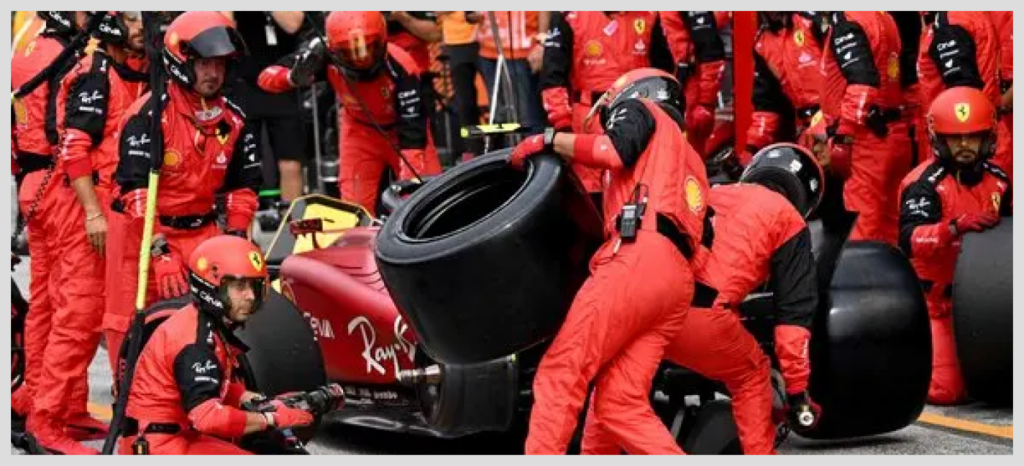Formula 1 is a high-speed racing competition featuring cutting-edge technology and skilled drivers. It attracts millions of fans and generates billions of dollars annually. Teams constantly innovate and develop new strategies to outsmart their rivals in pursuit of victory, and these strategies are one of the most important things that become the victim of cyber attacks or espionage.

With the sport’s ever-increasing reliance on technology and data analytics, cybercriminals are increasingly targeting F1 teams, trying to exploit vulnerabilities in the systems to steal sensitive data or compromise the digital infrastructure of cars.
This article explores the potential cyber threats that F1 faces. In addition, it covers the most significant cyberattacks and data breaches in the sport’s history and how F1 teams fight back against cyber threats.
Why cybersecurity is vital in Formula 1

If you follow and watch F1 live stream, you must understand the importance of cybersecurity for the event today, too. If an F1 team doesn’t secure its data, it can lead to significant consequences that can affect the team’s performance and reputation off the track. Here are some potential outcomes:
- Loss of competitive advantage: F1 teams use significant resources in research and development to gain a competitive edge, which can include aerodynamics, engine performance, and constructors’ strategies. However, they could lose to their rivals if their sensitive data is exposed to rival teams or other adversaries.
- Financial loss: A data breach can result in significant financial loss for an F1 team. The team may need to spend money on investigations, legal fees, and remediation efforts. Additionally, a data breach can lead to a loss of revenue, as sponsors and fans may lose confidence in the team.
- Reputational damage: A data breach can also cause significant damage to an F1 team’s reputation. The team may be perceived as incompetent or careless, affecting their ability to attract new sponsors, fans, and talent.
What F1 data comes at stake during a cyberattack?
F1 team systems hold a wide range of sensitive information which could be exposed, including;
- Car designs: F1 teams invest heavily in creating unique and innovative car designs that give them a competitive edge on the track. If these designs are exposed to rival teams, the team could lose its competitive advantage.
- Telemetry data: F1 cars have various sensors that collect data during a race, including speed, acceleration, and tire pressure information. If this data is exposed, rival teams could use it to gain insights into the team’s race strategy and improve their performance.
- Race strategy: F1 teams spend a lot of time and resources developing their race strategy, including when to pit, how much fuel to use, and when to push the car to its limits, and if this information is exposed, rival teams could use it to their advantage.
- Employee and financial data: F1 teams also hold confidential information about their employees, such as contracts and salary information. They also have financial data, such as budgets and sponsor contracts. If this information is exposed, it could lead to legal and financial repercussions for the team.
Additionally, F1 teams must comply with a range of regulations related to data privacy, such as the GDPR (General Data Protection Regulation) in Europe, which could lead to penalties and sanctions.
Cyber threats faced by F1 teams

F1 teams usually encounter known cyber threats such as ransomware and phishing attacks. However, they may also experience more severe and malicious threats, including spying and intentional data breaches. These threats can have severe consequences and pose significant risks to the confidentiality and integrity of F1 teams’ data.
Here are the details of some of the most significant cyber threats F1 teams face:
1. Insider threats
Insider threats are among the most dangerous threats F1 teams face. Insiders are trusted individuals with authorized access to sensitive information or systems and can use their access to steal data or cause damage intentionally or unintentionally. F1 teams must ensure they have adequate access controls and monitor employees’ behavior to mitigate the risk of insider threats.
2. DDoS attacks
Distributed Denial-of-Service (DDoS) attacks are a type of cyberattack that aims to disrupt or disable a target’s network or website. Cybercriminals can launch DDoS attacks to overload F1 teams’ websites, rendering them unavailable to fans or disrupting internal communication systems.
3. Malware attacks
Malware attacks refer to various types of malicious software, including viruses, worms, and Trojan horses. These attacks can infect F1 teams’ computer systems and cause significant damage by stealing data or taking control of systems.
4. Intellectual property theft
Intellectual property theft is one of the most severe threats F1 teams face. Cybercriminals can steal valuable data like car designs, telemetry, and simulations that give competitors a competitive advantage. This can devastate the sport’s integrity and F1 teams’ reputation.
5. Data breaches
A data breach occurs when cybercriminals gain unauthorized access to a target’s computer systems and steal sensitive data. F1 teams have a vast amount of sensitive and valuable data, and a data breach can lead to significant financial and reputational damage.
6. Cyber espionage
Cyber espionage is a cyberattack where cybercriminals use sophisticated techniques to steal sensitive data like intellectual property or team secrets. F1 teams’ data is precious, and cybercriminals may attempt to steal this data for financial gain or to gain a competitive edge.
Major data breaches and cyberattacks in the history of F1

With vast amounts of data being generated and exchanged daily, the risk of cyberattacks and breaches in the F1 industry is significant. Over the years, several high-profile cyberattacks and data breaches have occurred, leading to sensitive data exposure and operational disruptions.
Ransomware attack on Ferrari and NFT scam (2022)
The Italian racing team Ferrari was hit by a cyberattack from a ransomware group known as RansomEXX. The group claimed to have stolen internal documents, manuals, and other data amounting to 7 gigabytes. The attack occurred after Ferrari dropped Kaspersky as a cybersecurity partner and sponsor.
In addition to the cyberattack, Ferrari faced an NFT scam in which a brand subdomain was compromised and used to host the scam. It occurred months after Ferrari announced its plans to create NFTs and was eventually identified and taken down.
Push Notification attack on the F1 app (2021)
In July 2021, fans of the Formula One app reported receiving cryptic notifications from the app. The notifications contained strange symbols and numbers, making fans speculate them as a code or a puzzle to solve.
The speculation was fueled by the fact that only the fans who had opted into receiving push notifications received those notifications. Some fans even believed the notifications related to a new secret feature of the app.
Disruption of Williams’s augmented-reality reveals (2021)
In March 2021, Williams Racing, one of the Formula 1 team, suffered a cyberattack disrupting the team’s augmented-reality (AR) app reveal.
Williams had planned to reveal its new livery through an AR app, which fans could download to view the new car design in 3D. However, a few hours before the launch, the team’s app was hacked, and fans could not access the AR feature. The hackers replaced the original content with an image of a cartoon character holding a flag with the word “HaHa” on it.
The team responded by canceling the AR launch and admitting the app’s compromise “by a malicious third party.”
Racing Point’s copying Mercedes break duct controversy (2020)
Racing Point was embroiled in a dispute in 2020 after its brake ducts were found to be a copy of Mercedes’ design. An investigation was conducted, and Racing Point was found guilty and fined 427,000 USD.
Some critics have suggested that the incident may have been a form of cyber espionage. That’s because it raised concerns about whether Racing Point had acquired Mercedes’s digital designs without authorization.
Renault Sports data breach by hacker group (2017)
In 2017, a hacker group accessed Renault Sport’s server and stole sensitive data related to the company’s F1 program. The group threatened to release or sell the data to competitors unless they received a ransom. The FIA encouraged Formula 1 teams to enhance their cybersecurity measures following the attack.
WannaCry ransomware attack on Honda (2017)
In 2017, Honda was hit by the WannaCry ransomware attack. The malware infected the company’s computer systems and demanded payment in exchange for data decryption.
Honda’s operations were significantly affected, leading to the temporary closure of multiple facilities. One of the closed facilities was the Sayama plant responsible for producing F1 engines supplied to Red Bull-owned teams. Thankfully, the attack did not have any impact on the races.
Data stolen from Mercedes (2015)
In 2015, Mercedes was embroiled in a data theft scandal after a disgruntled employee (Benjamin Hoyle) stole technical data about the team’s F1 car and attempted to sell it to a rival team.
According to reports, Hoyle accessed and recorded raw data, engine mileage, and damage details from the 2015 Hungary Grand Prix and saved the information on his computer. Mercedes eventually caught and fired him, and the FIA also banned him from working in F1.
Trojan virus on Marussia (2014)
In 2014, Marussia suffered a cyberattack in which a Trojan virus infected the team’s computer systems and caused significant damage. The team lost valuable data, and its F1 car performed poorly in the upcoming race. However, the virus only impacted the team’s servers, not the car. However, it prompted concerns regarding the potential for an F1 car to be hacked while in motion.
Hamilton’s Twitter overshares (2012)
In 2012, Lewis Hamilton accidentally tweeted sensitive telemetry data about his team’s F1 car during a testing session. The tweet was quickly deleted, but it caused significant embarrassment to the team.
Hamilton posted telemetry data on Twitter to demonstrate his belief that his teammate Jenson Button was receiving preferential treatment in car setup, which he believed was putting him at a disadvantage.
The move caused controversy. Some even accused Hamilton of breaking the trust between the driver and the team by publicly sharing the data.
McLaren cyber espionage on Ferrari (2007)
In 2007, McLaren was found to have obtained confidential technical information from Ferrari. The incident led to a significant scandal in the F1 world.
Nigel Stepneys, a Ferrari engineer, leaked confidential technical information to Mike Coughlan, McLaren’s chief designer, including design drawings, testing data, and radio codes. As a result, McLaren was fined 100 million USD and excluded from the 2007 Constructor’s Championship. At the same time, Coughlan and team principal Ron Dennis had to resign. Stepneys received a suspended prison sentence and a 640 USD fine for his involvement in the scandal.
How Formula 1 teams ensure adequate cybersecurity

Cyber security is becoming a primary concern for the integrity and confidentiality of F1 data. So, most F1 teams have invested heavily in sophisticated technologies to protect their data against cybercriminals and insider threats. All teams have partnered with cybersecurity companies to help safeguard their valuable data.
Partnering with cybersecurity firms
Formula One announced a partnership with cyber operations firm Herjavec Group in March 2021. Herjavec Group became the series’ official cyber security services partner and used its remote cloud operations center to detect and prevent possible security threats to Formula One.
The company provided support in three areas; securing the Formula One technical center, detecting and preventing threats in corporate operations and digital platforms, and leading initiatives in emergency preparedness. The partnership aimed to protect Formula One’s infrastructure as the series continued to expand its leadership as the pinnacle of motorsport.
An excellent example of how partnering with cybersecurity companies is helping F1 teams is how Darktrace (McLaren’s official cybersecurity partner) helped to thwart a phishing attack directed at McLaren’s group CEO, Zak Brown, in Emilia Romagna Grand Prix in 2020.
The attack email, disguised as an official business-related email, contained a malicious link. Thankfully, it landed in Zak’s junk mail thanks to Darktrace’s sophisticated security systems.
Cybersecurity measures from F1 teams

While partnerships between F1 teams and cybersecurity companies are excellent steps toward protecting teams from cyber threats, they are not foolproof.
The Williams FW43B Formula 1 team suffered a cyberattack in 2021, despite having Acronis, a cybersecurity firm, as its partner. The attack exposed sensitive data, including car designs and the team’s financial information.
This case highlights that even with cybersecurity measures in place, F1 teams must remain vigilant and continuously improve their security practices to stay ahead of evolving cyber threats.
Here are some of the common methods F1 teams use to prevent cybercriminals:
1. Independent third-party security assessments
F1 teams regularly engage third-party security experts to perform security assessments on their systems. These assessments help identify vulnerabilities and security gaps in their networks, applications, and other critical assets. The assessment report provides F1 teams with actionable recommendations to address the identified weaknesses, improving the overall security posture.
2. System vulnerability scanning and penetration testing
Vulnerability scanning and penetration testing are critical components of Formula 1 teams’ cybersecurity strategy. These techniques identify network and application vulnerabilities, simulating real-world attacks to determine the extent of damage the vulnerabilities can cause. Considering the results, F1 teams take remedial actions for the identified issues and reduce the chances of a successful cyberattack.
3. Creating Network Segments
Network segmentation is an effective way to limit the potential impact of a cyberattack. F1 teams use this technique to isolate critical systems and data, creating a barrier between the network segments. This makes it more challenging for cybercriminals to move laterally in the network and access sensitive data.
4. Employee training
Formula 1 teams recognize that employees can inadvertently cause cybersecurity breaches by falling prey to phishing emails or using weak passwords. Therefore, they provide regular training sessions to their employees on cybersecurity awareness, including the importance of using strong passwords, detecting phishing emails, and identifying suspicious activities.
5. Multi-factor authentication (MFA)
F1 teams use multi-factor authentication (MFA) to add a layer of security to their networks and applications. Multi-factor authentication requires a user to provide more than one authentication factor, like a password and a secret code sent to their mobile device, before granting access. It creates an additional security layer, preventing attackers from gaining unauthorized access, even after obtaining the user’s password.
6. Firewall protection
F1 teams use firewall protection as a standard security measure to protect their networks from unauthorized access. This is a barrier between the internal network and the public internet, monitoring and controlling incoming and outgoing traffic. F1 teams use advanced firewalls that can identify and block malicious traffic, reducing the chances of a successful cyberattack.
7. Sophisticated data encryption
F1 teams use data encryption to protect sensitive information from unauthorized access. Encryption converts plain text into a coded language that can only be readable with the correct key. This ensures that even if attackers can access the data, they cannot read it without the decryption key.
8. Securing endpoints and devices
Endpoints like laptops and mobile devices often constitute the weakest link in a network’s security. F1 teams secure their endpoints using endpoint protection software that detects and blocks malware, restricts access to sensitive data, and monitors endpoint activity. They also enforce strict device usage policies, prohibiting personal devices from accessing the network.






